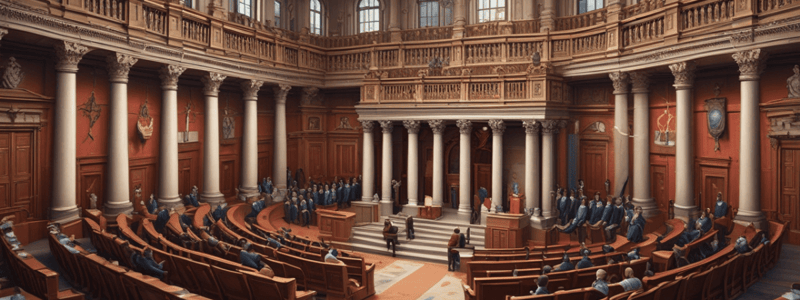Podcast
Questions and Answers
What is the difference between adoption and promulgation in the legislative process?
What is the difference between adoption and promulgation in the legislative process?
Adoption refers to the constitutionally prescribed processes and procedures required for draft legislation to become law. Promulgation refers to putting legislation officially and legally into operation through publication.
What is the purpose of the enacting clause in legislation?
What is the purpose of the enacting clause in legislation?
The enacting clause indicates who promulgates the legislation.
Explain the issue addressed in the case Section 14 of the Interpretation Act.
Explain the issue addressed in the case Section 14 of the Interpretation Act.
The enabling Act does not have the force of law yet because the President needs to promulgate it, but without the enabling Act being in force, the President does not have the authority to promulgate the Act, creating an 'endless circle of invalidity'.
What is the common law presumption regarding the application of legislation?
What is the common law presumption regarding the application of legislation?
What is one of the reasons given for the presumption that legislation only applies to the future?
What is one of the reasons given for the presumption that legislation only applies to the future?
According to the Cats Entertainment case, what can relevant functionaries do before an Act is in force?
According to the Cats Entertainment case, what can relevant functionaries do before an Act is in force?
What are the two main purposes of the rule against retrospective legislation?
What are the two main purposes of the rule against retrospective legislation?
What is the difference between 'retroactive' and 'retrospective' legislation?
What is the difference between 'retroactive' and 'retrospective' legislation?
What is a 'legal fiction' and a 'deeming clause'?
What is a 'legal fiction' and a 'deeming clause'?
What are the five obstacles to retrospective legislation mentioned in the text?
What are the five obstacles to retrospective legislation mentioned in the text?
What are the two exceptions to the presumption against retrospective legislation mentioned in the text?
What are the two exceptions to the presumption against retrospective legislation mentioned in the text?
What is the key principle from the S v Ndiki case regarding retrospective legislation?
What is the key principle from the S v Ndiki case regarding retrospective legislation?



